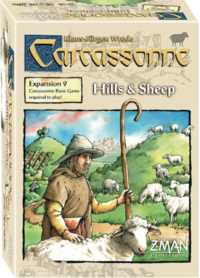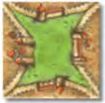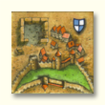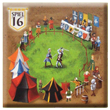Schapen en Heuvels (1e editie)
Algemene informatie en opmerkingen
Schapen en Heuvels werd oorspronkelijk in Template:Year nl uitgegeven door Hans im Glück.
Dit is de negende grote uitbreiding voor Carcassonne en introduceert een paar nieuwe aspecten aan het spel.
De herders op de weiden rondom Carcassonne wachten geduldig tot hun kudde schapen zich verzamelt. Ze moeten alleen wel uitkijken dat er geen wolf opduikt voordat ze hun kudde veilig naar de stal hebben gedreven. Vanaf de heuvels kun je de controle krijgen over wat eerst verloren leek. En verder is menig monnik maar wat blij met een wijngaard in de directe omgeving van zijn klooster.
Speelmateriaal
- 18 nieuwe landtegels
- 18 schaaps- en wolfsfiches (4x 1 schaap, 5x 2 schapen, 5x 3 schapen, 2x 4 schapen, 2x wolf)
- 1 zak
- 6 herders in 6 kleuren
Spelregels
Voorbereiding
Stop de schaaps- en wolfsfiches in de zak. Elke speler krijgt de herder van zijn kleur en zet die bij zijn horigen. De nieuwe landtegels worden met de andere geschud. Met uitzondering van de nieuwe spelregels van deze uitbreiding, zijn alle basisspelregels van Carcassonne ongewijzigd van toepassing.
Landtegel leggen
De spelers trekken tegels en leggen die volgens de gebruikelijke spelregels aan.
Herder en schapen
Herder gebruiken: Als een speler een landtegel aanlegt met een weidedeel, mag hij kiezen of hij er, zoals gebruikelijk, een horige op zet of dat hij in plaats daarvan zijn herder op het weidedeel zet. Als hij de herder zet, trekt hij een fiche uit de zak. Trekt hij een schaapsfiche, dan legt hij die bij zijn herder op de weide. Wordt er een wolfsfiche getrokken, dan gaat die terug in de zak en neemt de speler de herder terug in voorraad. Als op de weide die die door de zojuist aangelegde tegel werd uitgebreid al een boer ligt, mag de speler nog steeds zijn herder op dat veld zetten, maar als er op dat veld al een andere herder staat, mag hij zijn herder niet zetten.
Kudde schapen uitbreiden: Als een speler de weide waar zijn herder staat uitbreidt door een nieuwe tegel aan te leggen, mag hij daar eerst een horige op zetten [1] volgens de gebruikelijke spelregels voor het zetten daarvan, [2] vervolgens mag hij kiezen uit de volgende twee speciale acties kiezen: [3]
- De kudde uitbreiden (door nog een fiche uit de zak te trekken)
- of
- De kudde naar de stal drijven (de schapen tellen)
De kudde uitbreiden
De speler trekt één fiche uit de zak. Er zijn nu twee mogelijkheden:
- Er wordt een schaapsfiche getrokken – De kudde blijft zich uitbreiden. De speler legt het schaapsfiche bij de andere in de buurt van zijn herder.
- Er wordt een wolfsfiche getrokken – De wolf jaagt de schapen weg! De speler moet nu alle schaapsfiches van de weide nemen en terugdoen in de zak (inclusief het wolfsfiche), en zijn herder terug in voorraad nemen zonder punten te krijgen.
De kudde naar de stal drijven
In plaats van een nieuw fiche uit de zak te trekken, mag de speler ook besluiten de kudde van zijn herder te tellen. Voor elk schaap dat op de fiches staat die hij op zijn weide verzameld heeft krijgt hij 1 punt (elk fiche is 1 tot 4 punten waard). Na het tellen doet de speler alle schaapsfiches van de weide terug in de zak en neemt zijn herder weer in voorraad.
More than one shepherd in a field: By subsequent joining of originally separate fields, more than one shepherd may be present in the same field. If this happens, all sheep in the newly-connected field are considered to be part of the same flock, and (if scored) will earn points for every shepherd in that field. Whenever a sheep token is added to a flock in this case, it will essentially score the same for every shepherd. If one of the shepherds decides to score his flock, all shepherds in that field score the same points (the total of all sheep on all tokens in that field) and all concerned players must return their sheep tokens to the bag and return the shepherds to their supply. If a player draws a wolf token from the bag, the flock is lost for all shepherds in that field. All sheep tokens in the entire field are returned to the bag (along with the wolf token), and all shepherds in that field are returned to players’ supplies without scoring.
The shepherd is not a follower: A player who wishes to score his shepherd must do so by using the “Herd the flock into the stable” action. [4] The shepherd is not influenced by any other game scoring, and also does not influence any other game scoring.
If any shepherds with their sheep are still present in fields at the end of the game, they do NOT score.
Special case: If a player surrounded a farm completely with roads or city walls, then the action Herd the flock into the stable triggers immediately for the shepherds farm. [5] [6]

If RED had decided to expand the flock and had drawn a wolf token, no points would have been scored by either player.
Hills
(Idea: Manfred Keller)
Place and occupy: If a player draws a land tile depicting a Hill, he immediately draws a second tile, keeping it face-down, and places it under the Hill tile without looking at the second tile. [7]
Then, according to the normal rules of placement, he places the two-tile-high Hill and may deploy a follower on it. Other than its increased height, any other features depicted on the Hill tile (city, road, and field) function as they do in the basic game.
Scoring effects of a Hill: When scoring a feature (city, road, or field) with more than one follower, a follower on a Hill breaks any ties in favor of the owner of that follower. The player with a follower on a Hill receives all of the points for that feature. In this case, any other players involved in the tie who do not have a follower on a Hill receive no points for the feature. [8] [9]
If there is no tie, a follower on a Hill has no additional special meaning. Followers on Hills are returned to a player’s supply as usual after a scoring. These Hill rules also apply to the final scoring at the end of the game.
Vineyards
Placement: A land tile depicting a Vineyard is placed according to the usual rules. Whenever a cloister is completed and scored, the owner receives 3 additional points for every Vineyard on any of the 8 land tiles surrounding the cloister. [10]
A Vineyard may contribute to the additional points of multiple cloisters.
If any cloisters remain incomplete at the end of the game, any surrounding Vineyards will score no additional points. [11]

New land tiles
(Idea: Jan König)
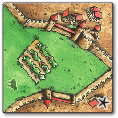
|
The right side of this tile is a "city side" with two separate city segments. If a tile with a city segment is placed next to it, the two segments are then connected. |
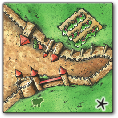
|
The right side of this tile is a "field side" with two separate field segments. If a tile with a field segment is placed next to it, the two field segments are then connected. |
Other expansions
Special rules for The Princess and the Dragon expansion
If the dragon moves to a land tile containing a shepherd (with his sheep tokens), the dragon eats the shepherd and all of his sheep. The player returns the shepherd to his supply and places the sheep tokens back into the bag. Note that this is an exception to the rule that states that the dragon only eats followers. [12] The sheep (and shepherd) simply look too delicious to the dragon, and unfortunately he can no longer restrain himself...
House rules
- If you’re not concerned about whether or not players count tiles as a strategy, and you want to be able to use all of the tiles in the game, you can place blank tiles under any hills that are drawn. (Thanks to Crispy Jones.)
Tile distribution
Total Tiles: 18
Total Tokens: 18
Voetnoten
Kijk op de Pictogrammen pagina voor uitleg over en licensering van de pictogrammen.
- ↑
 Hier zou eigenlijk moeten staan dat de speler volgens de gebruikelijke spelregels een speelstuk mag inzetten, aangezien elke geldige inzet van een speelstuk (zoals het varken of de bouwmeester) hier toegestaan zijn. (7/2014)
Hier zou eigenlijk moeten staan dat de speler volgens de gebruikelijke spelregels een speelstuk mag inzetten, aangezien elke geldige inzet van een speelstuk (zoals het varken of de bouwmeester) hier toegestaan zijn. (7/2014)
- ↑
 In de oorspronkelijke ZMG-versie van de spelregels stond dat de herdersactie eerst gekozen wordt, en dat daarna indien gewenst volgens de gebruikelijke spelregels een horige mag worden gezet. Dat zou strategische gevolgekn kunnen hebben, omdat de resultaten van een poging om de kudde uit te breiden gevolgen zouden kunnen hebben voor het al dan niet zetten van een horige volgens de oorspronkelijke ZMG spelregels. (En aangezien met het woord "horige" eigenlijk "speelstuk" wordt bedoeld, zou je met de oorspronkelijke ZMG-spelregels de herder terug op de weide kunnen zetten onmiddellijk nadat hij er door een wolf vanafgeschopt was!) Dit is sindsdien gecorrigeerd. (7/2014, updated 3/2015)
In de oorspronkelijke ZMG-versie van de spelregels stond dat de herdersactie eerst gekozen wordt, en dat daarna indien gewenst volgens de gebruikelijke spelregels een horige mag worden gezet. Dat zou strategische gevolgekn kunnen hebben, omdat de resultaten van een poging om de kudde uit te breiden gevolgen zouden kunnen hebben voor het al dan niet zetten van een horige volgens de oorspronkelijke ZMG spelregels. (En aangezien met het woord "horige" eigenlijk "speelstuk" wordt bedoeld, zou je met de oorspronkelijke ZMG-spelregels de herder terug op de weide kunnen zetten onmiddellijk nadat hij er door een wolf vanafgeschopt was!) Dit is sindsdien gecorrigeerd. (7/2014, updated 3/2015)
- ↑
 Als er een tegel met een draak-symbool wordt aangelegd die de weide met de herder van de speler die aan de beurt is uitbreidt, mag de speler de herder-actie (uitbreiden of naar de stal drijven van de kudde) uitvoeren voordat de draak op jacht gaat. (3/2015)
Als er een tegel met een draak-symbool wordt aangelegd die de weide met de herder van de speler die aan de beurt is uitbreidt, mag de speler de herder-actie (uitbreiden of naar de stal drijven van de kudde) uitvoeren voordat de draak op jacht gaat. (3/2015)
- ↑
 An early version of the HiG rules incorrectly stated that the shepherd must use the “Expand the flock” action in order to score. (5/2014)
An early version of the HiG rules incorrectly stated that the shepherd must use the “Expand the flock” action in order to score. (5/2014)
- ↑
 The German rules in the Big Box 5 from 2014 include this sentence. The English Big Box rules differ from the German ones in this point because this special case was added to the German rules at the request of correction readers shortly before printing.
The German rules in the Big Box 5 from 2014 include this sentence. The English Big Box rules differ from the German ones in this point because this special case was added to the German rules at the request of correction readers shortly before printing.
This addition refers to a special case when a farm is surrounded and "closed" with roads and cities so it cannot expand anymore. At that point the shepherd scoring takes place: The player gets points for the sheep, the sheep go back into the bag, and the shepherd goes back to the player's supply. (12/2015)
 No farm scoring happens at this point. The surrounded farm will be scored at the end of the game as usual.
No farm scoring happens at this point. The surrounded farm will be scored at the end of the game as usual.
- ↑
 The same special case should apply when placing a shepherd on an inner farm. Inner farms are present on several CCCC or CCCF tiles, so they closed by city walls and cannot be extended. In this case, you would place the shepherd on the inner farm, perform the Expand the flock action and, if no wolf token was drawn, you would perform the Herd the flock into the stable action automatically since the filed is already closed. These are examples of CCCC tiles with inner farms:
The same special case should apply when placing a shepherd on an inner farm. Inner farms are present on several CCCC or CCCF tiles, so they closed by city walls and cannot be extended. In this case, you would place the shepherd on the inner farm, perform the Expand the flock action and, if no wolf token was drawn, you would perform the Herd the flock into the stable action automatically since the filed is already closed. These are examples of CCCC tiles with inner farms:
These are examples of CCCF tiles with inner farms:
The following CCCC tile doesn't show an inner farm as it is not surrounded by walls or roads as a regular farm. The green patch serves just as a decoration for a jousting scene. (In any case, it would be rather odd to have shepherds and flocks around knights in a jousting tournament, right?)
- ↑
 If the Hill tile drawn is the last tile in the game, the player is still allowed to place it without a second tile underneath. The normal turn (move wood, score features) then takes place. Note that generally a tie break would not be possible with this tile – even if a follower is placed on it, there will be no way to connect that follower to an occupied feature, as the game will be over. (10/2014)
If the Hill tile drawn is the last tile in the game, the player is still allowed to place it without a second tile underneath. The normal turn (move wood, score features) then takes place. Note that generally a tie break would not be possible with this tile – even if a follower is placed on it, there will be no way to connect that follower to an occupied feature, as the game will be over. (10/2014)
- ↑
 If the tied players also have equal numbers of followers on hills in that feature, the tie remains unbroken and both players still receive the points. Even if the number of followers on hills is unequal, as long as each of the tied players has at least one follower on a hill, the tie is unbroken and both players receive the points. (5/2014)
If the tied players also have equal numbers of followers on hills in that feature, the tie remains unbroken and both players still receive the points. Even if the number of followers on hills is unequal, as long as each of the tied players has at least one follower on a hill, the tie is unbroken and both players receive the points. (5/2014)
- ↑
 As an alternative tiebreaker method, the number of followers on hills can be counted. Thus, if two players have the same number of followers in a feature, but one player has more of those followers on hills than the other player does, the player with the most followers on hills gets all of the points and the other player gets none. (5/2014)
As an alternative tiebreaker method, the number of followers on hills can be counted. Thus, if two players have the same number of followers in a feature, but one player has more of those followers on hills than the other player does, the player with the most followers on hills gets all of the points and the other player gets none. (5/2014)
- ↑
 The vineyard bonus is also applied to the Abbey tile (Abbey and the Mayor) and Cult Places. When using German/Dutch and Belgian Monasteries, the vineyard bonus is applied to the Monastery if the follower is placed as a monk and the feature is scored as a finished cloister. However, the vineyard bonus is not applied if a follower is placed as an abbot on a Monastery, as the abbot scores only at the end of the game, when the vineyard has no effect. (5/2014)
The vineyard bonus is also applied to the Abbey tile (Abbey and the Mayor) and Cult Places. When using German/Dutch and Belgian Monasteries, the vineyard bonus is applied to the Monastery if the follower is placed as a monk and the feature is scored as a finished cloister. However, the vineyard bonus is not applied if a follower is placed as an abbot on a Monastery, as the abbot scores only at the end of the game, when the vineyard has no effect. (5/2014)
- ↑
 Regardless of the type of cloister involved (normal cloister, Abbey, Cult Place, or German Monastery), the vineyard has no effect on final scoring at the end of the game. (5/2014)
Regardless of the type of cloister involved (normal cloister, Abbey, Cult Place, or German Monastery), the vineyard has no effect on final scoring at the end of the game. (5/2014)
- ↑
 This is an odd clarification / special rule, as the premise is not actually correct. The dragon actually does eat all players’ figures (other than the barn), so eating the shepherd does not represent a change in the rules. (The 2013 The Princess and the Dragon rules have a specific bullet point stating that all players’ figures, not just followers, are fair game for the dragon – this predates the Hills & Sheep expansion.) (1/2015)
This is an odd clarification / special rule, as the premise is not actually correct. The dragon actually does eat all players’ figures (other than the barn), so eating the shepherd does not represent a change in the rules. (The 2013 The Princess and the Dragon rules have a specific bullet point stating that all players’ figures, not just followers, are fair game for the dragon – this predates the Hills & Sheep expansion.) (1/2015)
- ↑
 Note that there is no expansion symbol on this tile. Errata included in the HiG packaging notes that one can tell that the tile is a part of this expansion by the presence of the hill. (5/2014)
Note that there is no expansion symbol on this tile. Errata included in the HiG packaging notes that one can tell that the tile is a part of this expansion by the presence of the hill. (5/2014)
